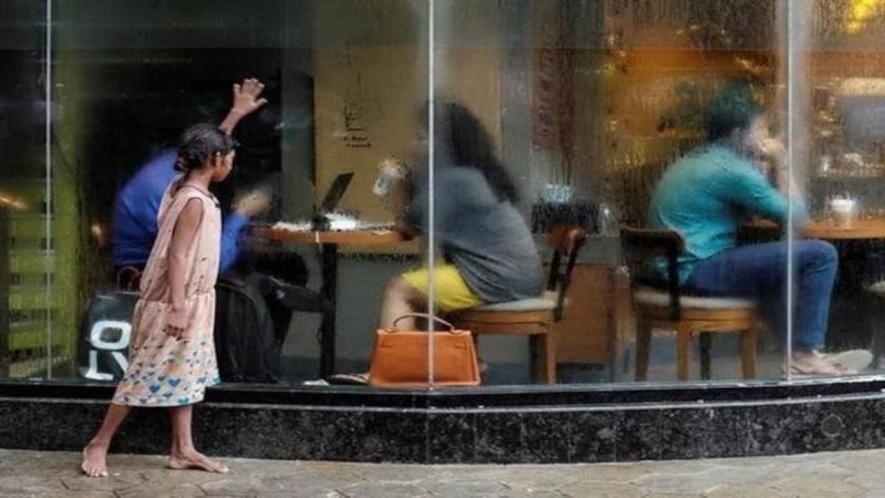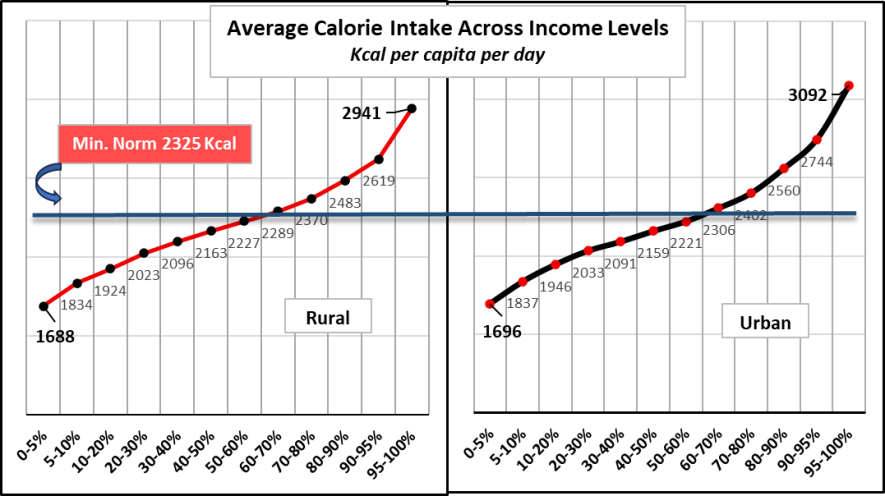Most of India Not Getting Adequate Nutrition: Govt Report

File Image
A recently released government report has thrown up a dismaying and worrisome picture of nutritional intake of people in India. On average, a rural person consumed 2,212 kilocalories (Kcal) per day while an urban resident took in 2,240 Kcal, in 2023-24. The norm set by the government’s experts for minimum calorific intake is 2,325 Kcal per day. So, average consumption in both rural and urban areas is less than the minimum requirement.
These results emerge from the survey report called Nutritional Intake in India released by the National Statistical Office (NSO) under the Ministry of Statistics and Programme Implementation (MoSPI). The survey report contains results for 2022-23 and 2023-24. A total of about 2.62 lakh people were surveyed, of which 1.55 lakh lived in rural areas and 1.07 lakh resided in urban areas.
Here is an important fact to be noted: the norm of 2,325 Kcal per day as the minimum energy intake was introduced in 2017-18. It was calculated by experts taking an adult man of 18-29 years of age leading a sedentary life. Till then, the norm used to be 2,700 Kcal per day, with all earlier NSSO reports using this higher norm. The drastic reduction in 2017-18 was done for obscure reasons.
Wide Variation Across Income Levels
As can be expected, this energy intake varies widely with incomes – poorer sections have much lower intake compared with richer sections of people. The report gives some of the details. The poorest 5% \of people consume just 1,688 Kcal (in rural areas) and 1,696 Kcal (in urban areas), on an average. At the other end, the richest 5% of people in the country consume 2,941 Kcal (in rural areas) and 3,092 Kcal (in urban areas). In fact, roughly 60-70% of the population consumes below the 2,325 Kcal norm, in both, rural and urban areas.

The report also gives protein intake data across income levels. While the poorest 5% of the population consumes about 44 grams of protein in rural areas and 46 grams in urban areas, the corresponding amounts for the richest 5 percent population are 86 grams in rural as well as urban areas.
The kind of food providing proteins to the consumer varies widely according to their income levels, the report shows. Among the poorest 5% of rural population, for example, 56% of protein intake comes from cereals, about 6% from milk and milk products and 9% from eggs, fish and meat. But among the richest 5% (rural), cereals are the source of only 34% \of protein intake, with milk and its products contributing 15% and eggs, fish & meat another 17% of proteins.
Cereals are not a very good source of protein compared with milk or its products, or eggs, fish and meat. But these foods are priced out of the poor families’ budgets. So, they are dependent on cereals only. This causes deficiency of proteins.
Interestingly, pulses are consumed almost in similar quantities across the income levels, with the poorest getting about 9% of their protein from pulses while the richest get about 9%.
In urban areas, protein sources are roughly similar to those in rural areas, except that the richest 5% get even less protein from cereals (24%). ‘Other’ sources of protein – including supplements, fruits, etc. – make up the biggest source of protein for urban rich at over 39% of total protein intake.
Fat intake, too, varies significantly with income levels. For example, the poorest 5% population consumes about 36 grams of fats per day in rural areas, and 42 grams per day in urban areas. Among the richest 5%, fat consumption per day is nearly 96 grams in rural areas and over 102 grams in urban areas.
The overall picture is one of extreme inequality and disparity with the poorer sections of people suffering from both low energy intake as well as lower diversity of nutritional sources.
Variation Across States
There is wide variation in energy intake across states. Among the 18 major states, in rural areas, only Andhra Pradesh, Bihar, Haryana, Odisha, Punjab, Rajasthan and Telangana have a consumption level that is higher than the norm of 2,325 Kcal per capita per day.
All other states exhibit levels that are below the norm. Assam (2,703 Kcal), Jharkhand (2,056 Kcal), Madhya Pradesh (2,089 Kcal), Maharashtra (2,072 Kcal), and Uttar Pradesh (2,086 Kcal) are notably below the minimum standard. In urban areas, Bihar, Chhattisgarh, Haryana, Punjab, Rajasthan and Telangana are the only states above the minimum norm.
A comparison between 2009-10 and 2023-24 nutritional intake reports shows that Assam, Maharashtra, Punjab and Uttar Pradesh are states where daily per capita calorific intake has declined in rural areas.
Over the past several years, there has been an attempt to prove that food security has been taken care of through various programmes, like the PM Garib Kalyan Yojana, PM Poshan, etc. However, despite these efforts, this report shows that nutritional intake is alarmingly deficient, laying the ground for chronic malnutrition and all its deadly consequences. Obviously, the prevailing low wage/earning economic system coupled with unemployment is perpetuating this dire situation.
Get the latest reports & analysis with people's perspective on Protests, movements & deep analytical videos, discussions of the current affairs in your Telegram app. Subscribe to NewsClick's Telegram channel & get Real-Time updates on stories, as they get published on our website.
























